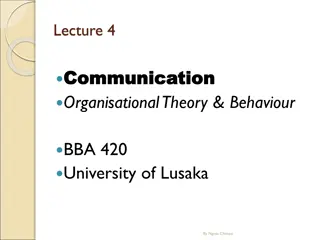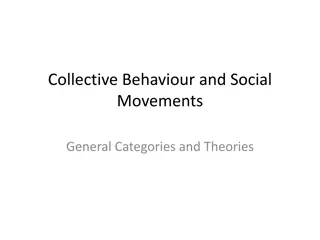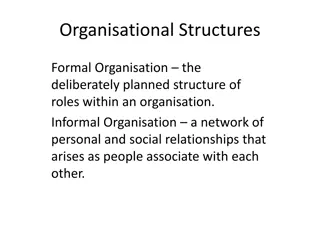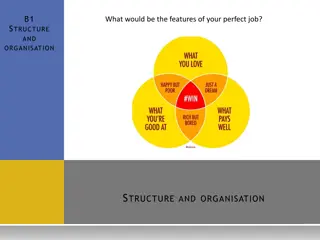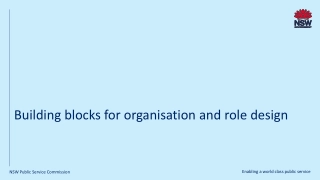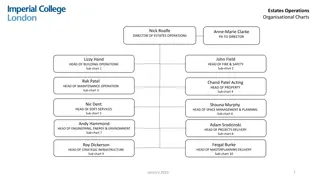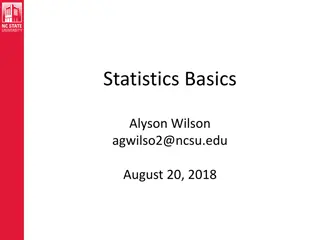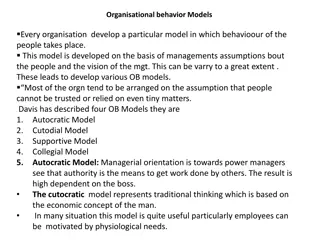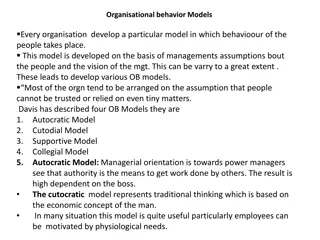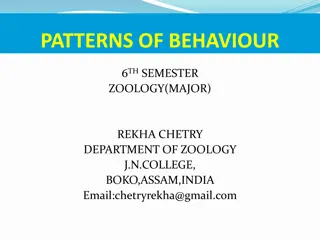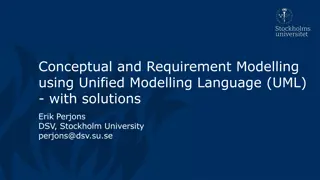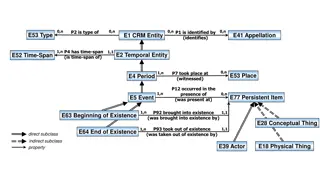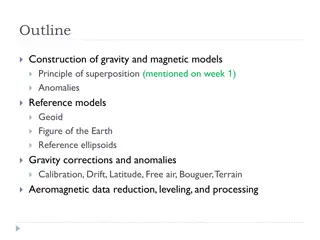Understanding Organisational Behaviour: Models and Concepts
The study of Organisational Behaviour (OB) explores human behavior within organizational settings, analyzing interactions at individual, group, and organizational levels. Key topics include the meaning of OB, its definition, and various models such as the S-R Model and S-O-B-A Model. This in-depth exploration sheds light on how individuals behave in organizations, highlighting the complexity and dynamics of human interactions within a professional environment.
Download Presentation

Please find below an Image/Link to download the presentation.
The content on the website is provided AS IS for your information and personal use only. It may not be sold, licensed, or shared on other websites without obtaining consent from the author. Download presentation by click this link. If you encounter any issues during the download, it is possible that the publisher has removed the file from their server.
E N D
Presentation Transcript
STET WOMENS STET WOMEN S COLLEGE COLLEGE SUNDARAKKOTTAI SUNDARAKKOTTAI MANNARGUDI MANNARGUDI DEPARTMENT OF BUSINESS ADMINISTRATION
ORGANISATIONAL ORGANISATIONAL BEHAVIOUR BEHAVIOUR MODELS MODELS Presented by ms.g.bharathi assistant professor business administration STET WOMEN S cOllEgE mannargudi
Contents Introduction Meaning of Organisational Behaviour Definition of Organisational Behaviour Models Conclusion
The study of Organizational Behaviour (OB) is very interesting and challenging too. It is related to individuals, group of people working together in teams. The study becomes more challenging when situational factors interact. The study of organizational behaviour relates to the expected behaviour of an individual in the organization.
MEANING Organizational behaviour (OB) or organisational behaviour is the: "study of human behaviour in organisational settings, the interface between human behaviour and the organization, and the organization itself". OB research can be categorized in at least three ways: Individuals in organizations (micro-level) Work groups (meso-level) How organizations behave (macro-level)
Definition Organizational behaviour can be defined as the study and application of knowledge about human behaviour related to other elements of an organization such as structure, technology and social systems (LM Prasad).
ORGANISATIONAL BEHAVIOUR MODELS
Organizational Behaviour - Models 1. The S-R Model 2. S-O-B-A Model
ORGANISATIONAL BEHAVIOUR MODEL:
1. The S-R Model This model assumes that the reasons which cause human behaviour are of two types: S-R Model (i) Internal Feeling (ii) External Environment Internal feelings of a person may relate to his motivational factor whereas the external environment which is also called the stimulus directly influences the activity of a person. The stimulus may be in the form of heat, light, etc. According to this approach, behaviour is determined by the stimulus or in other words the external environment forces determine the behaviour of a person at any given moment. There is a direct relation between stimulus and response that is why this process is called S-R process.
Limitations of SR Model The basic drawback of this model is that organism or person is immobile and passive. Whereas in reality the person concerned plays an important role in behaviour which is influenced by the internal feelings of the person. This model, thus, does not give a complete picture as to what caused the person to act in a particular way in a particular situation.
2. S-O-B-A Model S-O-B-A model is a comprehensive model of human behaviour which combines the S-R situation and human being. But O in this model is not passive or immobile, but it is a mediating, maintenance and adjective function between S and R. S-O-B-A model at times is also referred to as S-O- B-A model
STIMULUS The S in this model stands for stimulus or the external environmental situation. It includes light, heat, sound, actions of supervisors or other aspects of environment to which a person is sensitive. The stimulus is very comprehensive and all encompassing in nature. It stimulates the organism or person into action, interrupt what they are doing and help them to make their choices. The stimulus incorporates all aspects of the environment-immediate stimulus, physical environment and socio-cultural environment.
ORGANISM The O in this model stands for the organism as the person. But this O does not stand for only the physiological being but also it includes the processes within the person e.g; heredity, maturity, knowledge, skills, values, perceptions, attitudes, personality and motivation. The double headed arrow between S and O indicates the interaction between the situation and organism.
BEHAVIOUR The B stands for behaviour. It includes both overt and covert behaviour such as body movements, talking, facial expressions, emotions, sentiments and thinking. The response of organism indicated by a single headed arrow is the behaviour. Behaviour is anything that a person does; it is not something that is done to a person.
ACCOMPLISHMENTS The A stands for accomplishments and consequences. When behaviour, in turn, acts on the outside world, it leads to accomplishment as shown by single headed arrow. It is assumed that the accomplishments may further change the stimulating conditions and thereby influence the subsequent behaviour or it may create new stimulus leading to new behaviour.
Organizational Behaviour Models Autocratic Model. The root level of this model is power with a managerial orientation of authority. ... Custodial Model. The root level of this model is economic resources with a managerial orientation of money. ... Supportive Model. ... Collegial Model.


